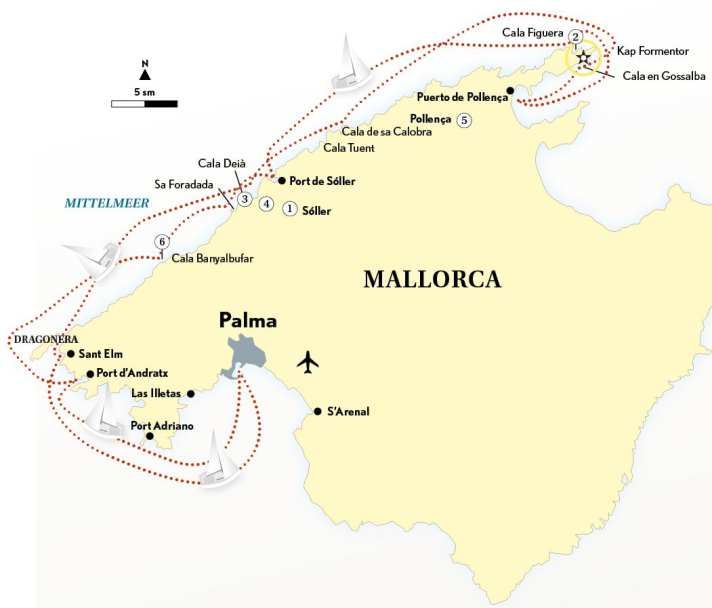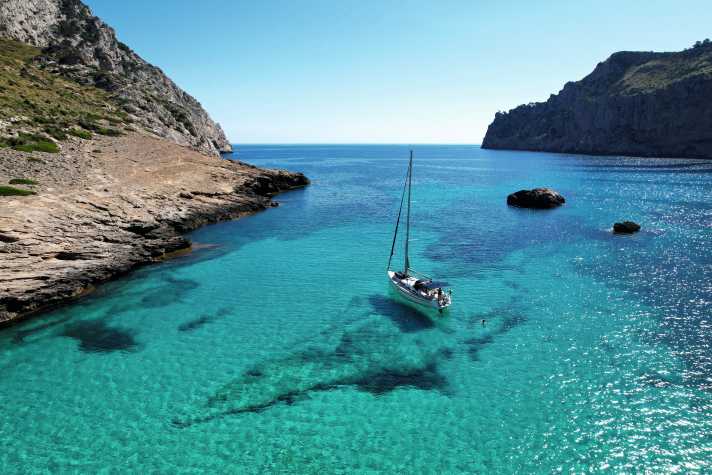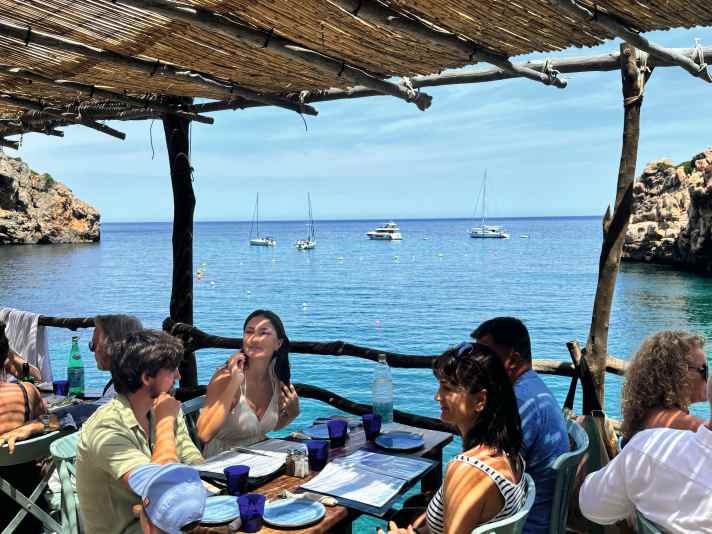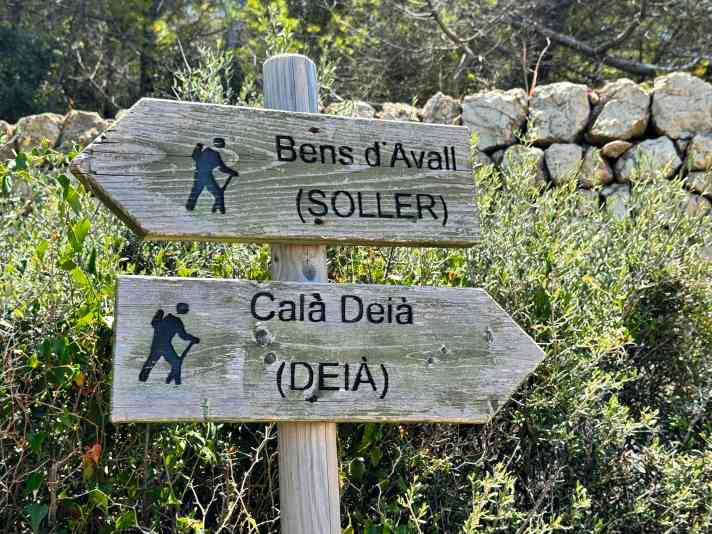





From the sea, the rugged cliffs of the Formentor peninsula, which drop steeply into the water, look spectacular, but not very inviting for anchoring. However, according to the area guide, the south-western tip of Cala Figuera hides an idyllic spot where you can spend the night well protected. We can hardly wait to jump into the water because it's hot and the engine has been driving us through the doldrums for hours. From the five-metre depth mark, the previously dark blue water suddenly turns turquoise. We carefully feel our way past the stones, then the anchor drops and digs itself into the sandy bottom.
No other boats for miles around, just a colourful parasol on the grey pebble beach. There is definitely more going on underwater: hundreds of fish cavort under the Bavaria, making snorkelling a real experience. When fellow sailor Olli flicks a few crumbs of dry bread into the water, the water really starts to bubble.
In the evening, amateur chef Hajø conjures up a Greek salad from Spanish ingredients and a homemade sangria. The night that follows is so wonderfully dark and starry at the same time that we lie in the cockpit for what feels like an eternity, looking upwards. As we fall asleep, we count the satellites that pass unperturbed by the fixed constellations.
But first things first...
From Palma to Port d'Andratx
The contrast to the start of the cruise in Palma could not have been greater. The packed airport with hordes of party tourists roaring loudly through the terminals was almost off-putting. Palma itself didn't give a relaxed holiday feeling either. Too many people, cars and Asian massage parlours vying for customers late into the night.
"I know exactly what you need now," Helge Kröger from Starsails greeted us as he handed over the boat. "The forecast for next week is more or less calm on the west coast. You should take advantage of this to explore the anchor bays that are otherwise very exposed in westerly winds. You'll love it!" No sooner said than done. That evening, we turn our backs on the island's capital and head for the lighthouse at Cap de Cala Figuera before turning north-west. After a night in the harbour of Andraitx, our "Ruckzuck" takes us into the strait between the island of Sa Dragonera and the westernmost point of Mallorca. It's like entering another world. All of a sudden, the buildings on the coast come to an end, replaced by the green mountains of the Tramuntana.
It is around 50 nautical miles to the northern tip of Mallorca along the mighty mountain range, which is a UNESCO World Heritage Site. Halfway there is Port de Sóller, the only sheltered harbour. Less than five miles away is the striking Na Foradada rock needle, which not only resembles an elephant lying on its belly, but is also an extremely popular anchorage.
One reason for this is the restaurant of the same name at the top of the cliff, which can only be reached by boat or on foot. It has earned a reputation for serving the best paella on the island. You can watch the dishes sizzle away on the crackling charcoal grill. Some Hollywood celebrities such as Michael Douglas and Tom Hanks have already dined here and helped the cliff to international fame. So it's not surprising that we share the anchorage with the 454-foot megayacht "Rising Sun", among others.
If you think you can spontaneously grab a seat with an exclusive ambience at "Na Foradada", you will usually be disappointed. It is advisable to book at least one or two days in advance. Next time for sure!
Also interesting:
From Port d'Andratx to Port de Sóller
The same applies if you want a safe berth in Port de Sóller: it is essential to contact the harbour master in good time. We are lucky and are allocated the last free berth on the outer pier of Marina Tramontana by radio, right next to an adjoining military area.
The best way to get from the harbour to the town of the same name is to take the historic tram. It first runs along the bay, then inland past orange and lemon groves. Sóller is framed by the foothills of the Tramuntana mountains and is famous for its citrus fruits. In the past, when the small town was still cut off and hardly served by transport, they were sailed directly to Marseille in France. The electric narrow-gauge railway, the "Red Lightning", has been running between Sóller and Palma since 1912. It once transported agricultural produce, but today it takes tourists over the mountain.
The shady alleyways of the beautiful old town are a pleasant retreat from the blazing sun. However, the crowds around the parish church of Sant Bartomeu are enormous. Tip: If you get up early, you can explore the villages of Bibibassi, Fortnalux and Biniaraix on a beautiful circular route from Sóller. The route is just under eight kilometres long and can be completed in around two hours in the morning. There are small cafés for a breakfast break in Fortnalux halfway along the route.
Back in the harbour, we watch as the mega-explorer "Moka" moors two berths backwards next to our Bavaria. What a spectacle! At a late hour, all the smaller boats dance in the swell, with only the 138-foot yacht lying on the water like a plank. "You'd be jealous of their stabilisers," mumbles Olli, toothbrush in mouth, before he sways and dives into the aft berth.
From Port de Sóller to Puerto de Pollença
The next day, we set course for Formentor. After a wonderful night at anchor there, the bleating of wild goats shatters the morning silence. Today we want to round the cape of the same name, which is both the easternmost end of the rugged peninsula and the northernmost point of Mallorca.
As soon as we leave the lee side, the wind picks up the sails and we head into the bay of Pollença at high speed. We leave the buoy field in Cala Formentor to starboard, as well as the lighthouse on the pointed headland at Punta Avenzada.
In Port de Pollença, there are still places on the northern outer pier. With a fresh breeze from the east, the mooring manoeuvre only succeeds on the third attempt; the marinero nevertheless accepts the stern line with an appreciative "Molt bé!", which means "very good" in Catalan. Flattered, we strike up a conversation to get tips for the shore leave. His English is about as good as our Catalan, but communication with hands, feet and a dose of humour works surprisingly well. Just an hour later, the crew are on their way on hire bikes towards Pollença, seven kilometres inland. Although the picturesque town nestled between the mountains is one of the most beautiful on the Balearic island, it has not succumbed to mass tourism.
At the beginning of the 20th century, painters, musicians and writers settled here, which is why the town is also known as an artists' colony. There are numerous galleries and boutiques to browse through in the centre of the winding old town.
The main attraction, however, is the flight of steps lined with cypresses and cacti that leads from the town centre to the Calvary. Those who climb the sweat-inducing 365 steps will be rewarded at the top with a magnificent view that stretches from Formentor across the bay of Pollença to the Alcudia peninsula. There is also an opportunity to refresh yourself with an ice cream or drink in the shade of the pilgrimage chapel perched on the summit.
From Puerto de Pollença to the Cala de sa Calobra
The next morning, we visit the market in Port de Pollença to stock up on fresh fruit. Afterwards, the crew look at the nautical chart together to discuss the next leg of the trip. The options are either to sail all the way round Mallorca or back along the west coast. We are so enamoured of the wild west and the lonely northern tip that the decision is unanimous: We had skipped a few bays on the way there. We now want to visit them too.
For example, the narrow Cala en Gossalba on the east side of Formentor. We stop there for a swim around midday. The numerous Aleppo pines on the rocks give the small cove an earthy, resinous scent. To protect the underwater flora, especially the seaweed, the anchor should only be dropped over the light-coloured, sandy patches on the seabed.
After rounding the cape again, we then sail around 20 nautical miles back through the calm to the spectacular Cala de sa Calobra. It is easy to anchor at a depth of ten metres in front of the deep gorge formed by torrents. However, only in stable, calm weather conditions. Otherwise, there is an unpleasant swell here, which is reflected by the rocky flanks.
Between steeply rising rocks, we discover a small shallow strip of shore that is suitable for landing with the dinghy. However, the coarse pebble beach is almost impossible to negotiate barefoot, so don't forget your shoes! Until the construction of a winding road in the 1930s, the village could only be reached by water. Today, Sa Calobra is one of Mallorca's top attractions: a free climber moves artistically like a spider on an overhanging rock, while a young bridal couple standing in the water is staged by a photographer. Other beachgoers enjoy the view of the anchored ships and the setting sun. It's hard to imagine that a life-threatening torrent could form here in heavy rain and sweep everything into the sea.
Later in the evening, a few young billy goats venture down to the beach to playfully bang their horned heads against each other. When the last of the sunlight has gone out, peace returns to the bay. Well, almost. The guests of a fully occupied party cat don't seem to be comfortable with the silence of the night; their roaring can still be heard for a while. And at the far end of the bay, a mega yacht lies like an illuminated bulwark against the wind and waves. We don't need that that night, the weather remains calm until the morning.
To Sant Elm
On the penultimate day, the crew would like to go out to eat again, preferably with a view over the sea. So we head for Cala Deià, which is around three nautical miles south of Port de Sóller and has two restaurants right on the water. We decide in favour of the one higher up, but have to wait a while for a table to become available. It's worth it: the grilled octopus tastes excellent and you can't sit any closer to the water with a view over the anchorage. Served with a glass of white wine - perfect!
Swim back to the boat with the dinghy. The bathing area is marked with yellow buoys and motorised dinghies are not allowed to enter.
As we pass Sa Dragonera in the early evening, it's time to say goodbye to the wild west coast. The buoy field off Sant Elm, the westernmost village on the island, offers a gentle transition back to the touristically overused Mallorca. There are no hotel blocks here, but instead an offshore island that can be reached by swimming.
We don't see any satellites last night, but the lights of the planes that show us the way back to Palma. Even without any wind to speak of, time has flown by.
Tips for anchorages and shore excursions

1 Sóller
A visit to this charming little town is a must. In Port de Sóller, the only port on the west coast, it is best to hop on the historic tram, which first runs along the beach and then through the Valley of Oranges to the centre of the old town.

2 Cala Figuera
This secluded bay lies high up in the north of the Formentor peninsula, framed by high cliffs. Crystal-clear, turquoise water and a sandy bottom are perfect for anchoring and snorkelling. There are no restaurants or shops. Cape Formentor is just a stone's throw away.

3 Cala Deià
An ideal stopover for hungry crews who don't want to lose sight of the boat. As the bay and the daytime restaurants are also popular with land-based tourists, it is better to book a table. The stop here is also an alternative if the restaurant in Na Foradada is full.

4 Coastal hike
As there are great hiking trails of all levels of difficulty in the north-west of Mallorca all the way to Formentor, it pays to pack good footwear. Port de Sóller and Cala Deià are also connected by an idyllic coastal path, which is twelve kilometres long.

5 Pollença
A visit to this beautiful and uncrowded artists' village is a memorable experience. It can be reached by bike, taxi or bus from the harbour of the same name. If you are looking for a special souvenir, you will find it here. The town's landmark is a 365-step flight of steps.

6 Cala Banyalbufar
Due to rocks, the anchor should be dropped in the outer area of the bay, before the eight-metre depth line. A visit to the mountain village of Moorish origin is well worthwhile. Wine used to be grown on the striking terraces, but today it is mainly fruit and vegetables.

Things to know for Mallorca's western route
Navigation & Seamanship
Navigation in the area is uncomplicated, just watch out for stones close to land. Weather reports and warnings are regularly broadcast in Spanish and English on VHF channel 16. In small bays in particular, use shore lines if necessary if there is not enough room to swing.
Wind & Weather
With 300 days of sunshine a year, the Balearic Islands are one of the most popular holiday destinations for charter crews. At the height of summer, temperatures fluctuate between 27 and 37 degrees Celsius. In the event of heavy rain, Cala de sa Calobra is prone to dangerous flash floods. Due to the comparatively mild winter, sailing and chartering is possible all year round with the right preparations.
Mostly weak, onshore wind during the day, offshore at night. With easterly winds, calm conditions can be expected in the west. Towards the end of the high summer, there may be more heat thunderstorms. The wind can then reach gale force in a very short time. These notorious, localised storms are called "Gota Fria" by the locals.
Harbours & anchorages
One of the special features of the area is that charter boats have to share some of the most beautiful spots with mega yachts. There is only one harbour, Port de Sóller, halfway along the entire west and northwest coast. It is necessary to book a berth. With swell and winds from the western quadrants, most anchorages are also unprotected. And: seagrass beds are protected and must not be damaged by anchors or chains. Anchor only on the light-coloured, sandy areas.
Literature & Charts
Cruising guide "Balearic Islands" by Gerd Radspieler, 39.90 euros, Delius Klasing Verlag. "Portbook Mallorca" by Martin Muth, 29.90 euros, BonaNova Books (new edition 2024). "Küstenhandbuch Mallorca", 39.90 euros, Edition Maritim. Reference: SHOP.DELIUS-KLASING.DE
Nautical Charts NV Charts "Spain ES2 - Balearic Islands, Ibiza to Menorca", 64.99 euros.
Charter
We were travelling with a Bavaria Cruiser 40 from Starsails Yachtcharter. Depending on the season, the boat costs between 1450 and 3050 euros per week (plus final cleaning, bed linen and towels). Information and booking: 0221/630 608 130; STARSAILS.DE

